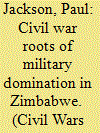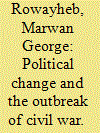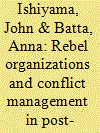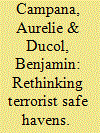| Srl | Item |
| 1 |
ID:
109230


|
|
|
|
|
| Publication |
2011.
|
| Summary/Abstract |
This article addresses the issue of what happens after a civil war ends. In particular it traces the development of political authoritarianism from an initial multiparty democracy and military integration following a civil war to one-party control and the breakdown of civil security following the rise of an alternative opposition. The post-conflict situation within Zimbabwe shows clearly how one faction was able to use their position to dismantle and incorporate opposition groups into a one-party state, despite considerable violence between former allies over seven years. A narrative history of the process and its aftermath provides a valuable insight into how these processes developed and the implications of actions taken during an integration process itself for subsequent political development.
|
|
|
|
|
|
|
|
|
|
|
|
|
|
|
|
| 2 |
ID:
109228


|
|
|
|
|
| Publication |
2011.
|
| Summary/Abstract |
This article expands on the conventional discourse relating rough terrain - mountainous terrain and noncontiguous territory - to civil war onset. In addition to their direct effects on the strategic and tactical logic of insurgency, I argue these factors affect state capacity, as measured by tax capacity, and exert an indirect effect through this channel. Because tax capacity proxies bureaucratic and administrative capacity as well as material resources, it conditions the decision to rebel more than military capacity per se. I find a negative relationship between mountainous terrain and to a lesser extent, noncontiguous territory, and state capacity. Subsequently, I find tax capacity is strongly and negatively associated with civil war onset, though this relationship appears only with longer than conventional temporal lags. The cumulative (direct + indirect effects mediated by state capacity) of rough terrain is roughly 45 per cent larger than its direct effect.
|
|
|
|
|
|
|
|
|
|
|
|
|
|
|
|
| 3 |
ID:
109232


|
|
|
|
|
| Publication |
2011.
|
| Summary/Abstract |
Although the Lebanon of post 2005 is similar in many respects to the Lebanon of the 1950s and 1970s, this article demonstrates that between 2005 and 2011 the country was in less danger of the outbreak of civil war than in 1958 or in 1975. The political circumstances that prevailed in 1958 and in 1975 had made the outbreak of a civil war in the interest of political actors. The introduction of some of the reforms introduced by the Taif Accord since 2005 made many actors more likely to use constitutional methods to resolve conflicts. When these methods failed, the protests were either peaceful or violent, but over short periods of time. On many occasions these protests brought the country to the brink of civil war. Nevertheless, these protests did not escalate into large-scale or long-term communal militant violence. This was not because of a sense of war weariness but because of the influence of the prevailing political circumstances that made the outbreak a civil war appear to be a strategic error.
|
|
|
|
|
|
|
|
|
|
|
|
|
|
|
|
| 4 |
ID:
109233


|
|
|
|
|
| Publication |
2011.
|
| Summary/Abstract |
How do the organizational features of rebel groups participating in civil wars affect the likelihood of the resumption of conflict after a civil war has ended? As many scholars have noted, peace duration is a function of the extent to which rebel groups stick to the deal. However, occasionally a rebel group fractures, and the conflict resumes as a result. Using a combination of existing data on civil conflicts and characteristics of the settlement agreement, along with original data on the characteristics of the insurgent organizations implementing the agreement, we test the effect of the organizational features of the rebel group on the duration of the peace settlements that occurred after the end of the cold war until 2009.
|
|
|
|
|
|
|
|
|
|
|
|
|
|
|
|
| 5 |
ID:
109231


|
|
|
|
|
| Publication |
2011.
|
| Summary/Abstract |
Over the last decade, the term safe haven has stirred controversy both in the political arena as well as in the academic literature. Several authors have emphasised the imprecise and commonly ill-conceived use of this terminology. This article intends to provide a fresh analytical framework to better understand the notion of terrorist safe haven. Rejecting the orthodox state-centric approach that envisions terrorist safe havens solely in their static and territorial dimensions, we focus rather on the social dynamics that characterise these spaces. We contend that although they might appear socially fragmented, these geographical areas are ruled by alternative modes of governance that impose a form of social order regulating interactions among actors. We use the concept of 'social space' to capture the framework in which social interactions between local actors are taking place. While we recognise that the social order that governs a given social space imposes constraints for actors, we contend that it can be subjected to internal contestation, opening a series of opportunities for transnational terrorist networks. We then try to highlight how terrorist groups might take advantage of these internal dynamics and create new ones to ensnare some local actors into forming alliances with them. This article addresses several case studies to further illustrate the theoretical discussion. Finally, we conclude with a discussion of the importance of interpersonal relationships between local and transnational actors. While this article proposes a preliminary analysis of the question, it opens up new research avenues in conceptualising why and how some regions have come to attract transnational terrorist groups.
|
|
|
|
|
|
|
|
|
|
|
|
|
|
|
|